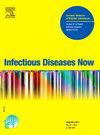2023年法国老年住院或住院患者吸入性肺炎全国调查
IF 2.2
4区 医学
Q2 INFECTIOUS DISEASES
引用次数: 0
摘要
背景:尽管吸入性肺炎是一种影响特定人群的常见感染,但在法国的肺炎指南中并未特别提到吸入性肺炎。法国传染病学会(法语缩写SPILF)建议小组和感染-老年病学小组(GinGER-SPILF SFGG)于2025年发布了关于这一主题的首批建议。本研究的目的是描述法国医生对75岁以上住院或住院患者吸入性肺炎的处理方法。方法:于2023年6月至11月在全国范围内对医院或医疗社会机构工作的医生进行调查,评估其从诊断到预防的习惯。结果:共有452名医生回复(主要是老年病专科医生、传染病专科医生和家庭医生)。诊断标准是双方自愿的:出现呕吐、吞咽障碍或吸入性肺炎病史。78%的医生报告说,他们会开辅助性检查的处方。影像学检查(74%)优先于细菌学检查(19%)。口服阿莫西林-克拉维酸是一线抗生素(82%)。在甲硝唑和皮下途径的使用上发现了显著的差异,后者更常被老年医生使用。老年病学专家将更多的患者推荐给语言治疗师。最常用的吞咽试验是水试验(92%)。吞咽障碍的筛查和管理、二级预防和营养管理因专业和实践环境而异。结论:本调查显示了对诊断标准和抗生素治疗的共识。然而,不同专业和实践环境在预防和营养管理方面的显著差异突出了具体建议的必要性。本文章由计算机程序翻译,如有差异,请以英文原文为准。
National survey on aspiration pneumonia in elderly hospitalized or institutionalized patients in France in 2023
Background
Aspiration pneumonia is not specifically addressed in French guidelines on pneumonia, despite it being a frequent infection affecting specific populations. The French Infectious Diseases Society’s (French acronym SPILF) Recommendations Group and the Infectio-Geriatrics Group (GinGER-SPILF SFGG) have published the first recommendations on this topic in 2025. The objective of this study was to describe practices of French physicians to manage aspiration pneumonia in hospitalized or institutionalized people aged over 75 years.
Methods
A nationwide survey conducted from June to November 2023 was distributed to physicians working in hospitals or medico-social facilities to assess their habits from diagnosis to prevention.
Results
A total of 452 physicians responded (mainly geriatricians, infectious disease specialists, and family physicians). Diagnostic criteria were consensual: presence of vomiting, swallowing disorders, or a history of inhalation pneumonia. Seventy-eight per cent of physicians reported prescribing complementary examinations. Imaging examinations (74%) were prioritized over bacteriology (19%). Oral amoxicillin-clavulanic acid was the first-line antibiotic (82%). Significant differences were found in the use of metronidazole and of the subcutaneous route, which were more frequently used by geriatricians. Geriatricians referred significantly more patients to speech therapists. The most commonly used swallowing test was the water test (92%). Screening and management of swallowing disorders, secondary prevention, and nutritional management varied according to specialties and practice settings.
Conclusion
This survey shows consensus regarding diagnostic criteria and antibiotic therapy. However, the significant variation in prevention and nutritional management across specialties and practice settings highlights the need for specific recommendations.
求助全文
通过发布文献求助,成功后即可免费获取论文全文。
去求助
来源期刊

Infectious diseases now
Medicine-Infectious Diseases
CiteScore
7.10
自引率
2.90%
发文量
116
审稿时长
40 days
 求助内容:
求助内容: 应助结果提醒方式:
应助结果提醒方式:


